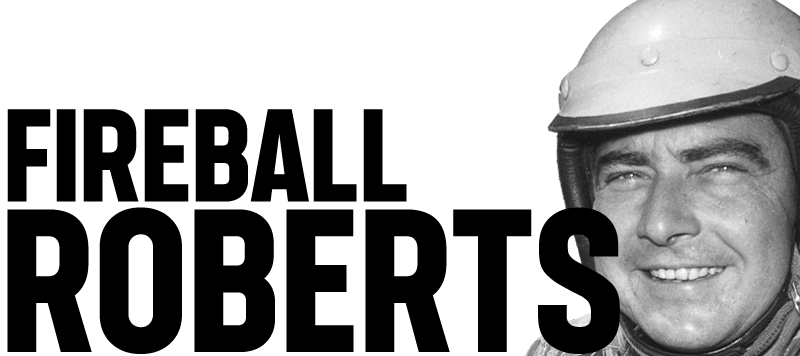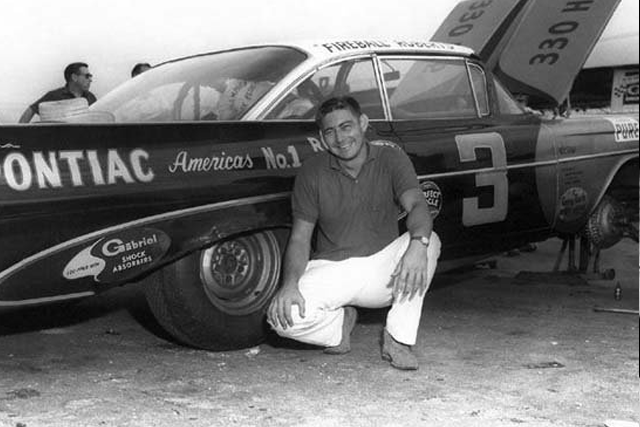20/1/1929 - 2/7/1964
Record updated 07-Feb-23
Giving a racing driver the nickname 'Fireball' in those days was clearly tempting fate. He had accumulated 33 wins, including the 1962 Daytona 500, in a career that spanned 16 seasons before his untimely death in 1964 at Charlotte Motor Speedway when those fates finally noticed the irony and conspired to arrange a suitably unpleasant demise for our man.

Perhaps the greatest driver never to win a NASCAR title, Edward Glenn Roberts was born on January 20, 1929 in Daytona Beach and raised in Apopka, Florida.
He started racing on dirt tracks while still at the University of Florida and, in 1947, raced on the Daytona Beach Course, crashing out after 9 laps of the Modified race. He returned the following year and took the win in the 150-mile race. He never graduated, turning to racing NASCAR full time in 1949 and finishing an impressive second to Bill Rexford in his rookie year. He split his time between the NASCAR Grand Nationals and the NASCAR Modifieds before returning full-time to NASCAR Grand National racing in 1956.

'Fireball' Roberts in 1959
Oddly enough, he didn't get the nickname through his on-track achievements. Rather, he earned it for his ability to throw a baseball from his years as a pitcher in youth baseball in Apopka. Thank goodness for the racing world, baseball was never his primary interest. Racing was. From the time he started on the beach course at Daytona when he was 19 where he wrecked on the ninth lap of a Modified race - until his untimely death in 1964, Roberts shaped a career that saw him with 35 poles and win 33 times and 22 runner-up positions in 206 races.
He set an astonishing 400 records at various tracks, leading a total of 5,970 laps including 1,644 laps led at tough, old Darlington Raceway, SC, NASCARS's first super speedway.

'Fireball' Robertss with his wife.
He won several times over the years, but it was on the fast, exciting new super speedways that began to crop up in the late '50s and early '60s that he made his mark. Darlington was his favorite super speedway and on it, Roberts became one of NASCAR's best in the fledgling start of the big track era.
He won the Rebel 300 in 1957 and 1959 and the Southern 500 in 1958 and 1963. In 1960, he won the Dixie 500 at Atlanta International Raceway.

The Holman-Moody Ford T-Bird shared with Ralph Moody, Chuck Daigh and Dick Rathmann in the Daytona 1000km seen here passing the much smaller Jomar 7C 113 of Ray Saidel and Paul Mansen.
Image by ISC Images & Archives via Getty Images
In 1959 he also made a departure into endurance racing when he entered the Daytona 1000km race to drive a Holman-Moody Ford T-Bird with Ralph Moody, Chuck Daigh and Dick Rathmann.
The race itself, though originally scheduled for 1,000 kilometers, was shortened to six hours which amounted to 147 laps of the 3.81-mile road circuit.
The race was won by Robert Mieres and Antonio von Dory in a Porsche RSK with the Roberts, Moody, Rathmann, Daigh Thurnderbird in 5th overall and 1st in class having covered 138 laps.
That was not the end to his road racing exploits... In February 1962, Roberts joined North American Racing Team (NART) to drive Ferrari 250 GT SWB in the Daytona 3 Hour race and then, in June, he made his debut at Le Mans 24 Hours in a NART Ferrari 250 GTO. Sharing the Number 17 Ferrari with Bob Grossman, they finished in the sixth place overall.

Fireball' Roberts No Ferrari on its way to 6th place at Le Mans 24 Hours race in 1962
After his European adventure at Le Mans, Roberts returned to the banked ovals of NASCAR, winning the 1962 Daytona 500 and July Firecracker 400 victories making him the first to sweep the speedway's two main events in a single season.

He still found time to race in both the 250 mile and three hour race at Daytona in 1963 in Ferraris and also raced a Shelby Cobra at Sebring though he posted a retirement.
His victory at Charlotte Motor Speedway that year was particularly significant. He came to the track in excellent physical shape after recovering from an injury. His plan was to start in the middle of the pack, which meant having to qualify on the second day. During practice however, he hit the guardrail in his No. 22 Holman-Moody Ford and almost washed the car out. But it was repaired in time for him to set a qualifying mark of 133.819 mph that got him the ninth starting spot.
Roberts was known as a predictable hard-charger, but he ran a uncharacteristically cautious race until the latter stages, when he then began to charge (lessons perhaps learnt from endurance racing?). He took the lead with only 75 laps left and won in a cakewalk. He had run the perfect race, saving man and machine.
In 1964, Fireball opened the season with a victory at Augusta International Raceway in the 22 Holman-Moody Ford. He next raced in the 250 mile American Challenge Cup race at Daytona in a Ford Fairlane Prototype finishing second. In the Daytona 500, he started 15th but stopped after just 13 laps due to a broken transmission.
On May 24, he started 11th at the World 600 at Charlotte and raced in the middle of the pack until lap 7 when he was involved in an accident with Ned Jarrett and Junior Johnson, who collided and spun in front of him. Fireball's Ford slammed backward into the wall, flipped over and burst into flames. Fireball was airlifted to a hospital in critical condition. He survived several weeks but a condition got worse and he died on July 2.
After his death, NASCAR made it compulsory for fireproof overalls to be worn. They also brought in five point safety harnesses, and the special drivers seats.
His 1920's Apopka, Florida home was in the way of commercial development. So it was relocated 1 mile to a residential area for a Mr. Marshall Howard in 1990.
HR
POPULAR DRIVERS FROM USA
Wendell Scott
Davy Jones
Mauri Rose
Stirling Martin
James Dean
Teddy Tetzlaff
Skip Barber
Rick Mears
Norm Houser
Greg Pickett